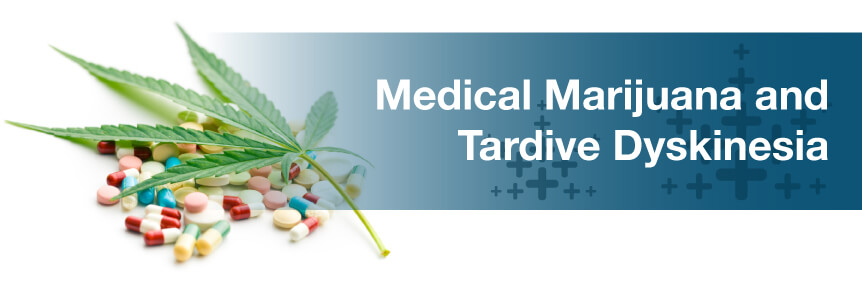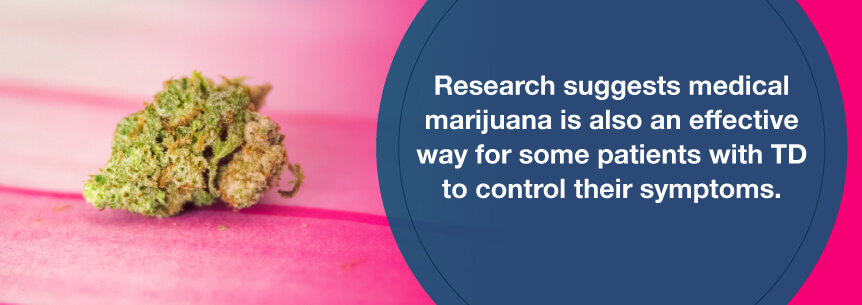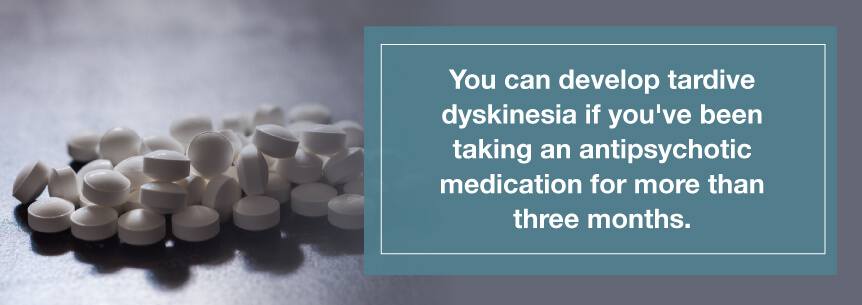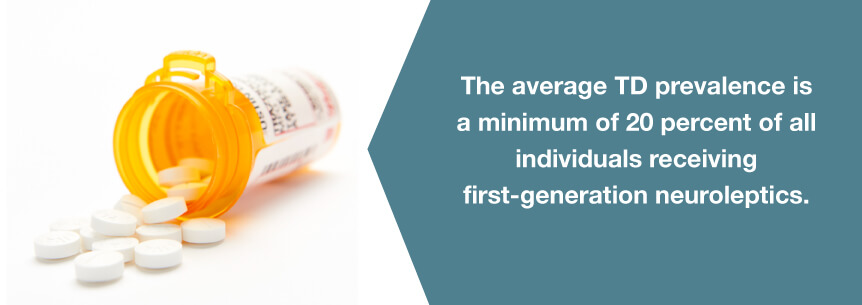
Many individuals have reported the benefits of cannabis — mostly the CBD cannabinoid in it — for treating anxiety, insomnia, pain, spasticity and a whole host of other ailments. It’s believed to be effective in treating epilepsy and acts as a wonderful muscle relaxant. Many Parkinson’s disease patients swear by its ability to reduce tremors. So, where do medical marijuana and tardive dyskinesia (TD) stand, then? First, you should know a little more about TD itself.
The basal ganglia contain an abundance of CB1R and CB2R endocannabinoid receptors, which implies they have something to do with normal motor function and medical marijuana formulations. As agonists at both areas, they could ease movement disorder symptoms.
Tardive dyskinesia symptoms are similar to the symptoms of Parkinson’s disease. Studies suggest medical cannabis can help certain patients effectively manage their symptoms, according to the National Parkinson’s Foundation. However, you shouldn’t replace approved TD treatments with medical weed. And there still needs to be more research into how using the herb long-term can affect the condition and confirm its results.
Many researchers started showing enthusiasm in studying medical marijuana about Parkinson’s disease after Parkinson’s patients began providing anecdotal reports on how the herb helped reduce their tremors. Some researchers believe medical pot could be neuroprotective — in other words, it saves neurons from Parkinson’s-related damage.
The digestive imbalance and endocannabinoid system play significant roles in Parkinson’s. THC, CBD and THCV research has shown medical marijuana is helpful in managing Parkinson’s disease symptoms.
In Kentucky, University of Louisville School of Medicine scientists have found cannabidiol (CBD) could have substantial therapeutic implications for PD.
The CBD cannabinoid activates the brain’s GPR6, a G-coupled protein receptor in the brain’s basal ganglia region. Since researchers can’t find the main endogenous compound binding to the GPR6 receptor, they consider it to be an “orphan receptor.”
Research shows a GPR6 depletion results in a dopamine increase, and GPR6 could potentially treat Parkinson’s. As you may know, Parkinson’s is a long-term, neurodegenerative condition impairing motor control due to a progressive loss of dopamine-producing neurons. CBD increases dopamine levels.
Find A Doctor Find A Dispensary
Medical marijuana is an effective medicine for the side effects of many well-known medical conditions such as cancer, HIV/AIDS, glaucoma, and more. But it is also effective in treating conditions many may have never heard of, such as tardive dyskinesia.
TD is a neurological disorder causing uncontrolled tremors and tic-like movements of the face, neck, arms, legs, hands and mouth. The symptoms are often similar to those of Parkinson’s disease and Tourette’s syndrome. TD is a serious side effect caused by certain medications, including Haloperidol, Fluphenazine, Trifluoperazine, Cinnarizine, Flunarizine and Metoclopramide (Reglan), and can become permanent even after stopping the use of such medications.
TD can be debilitating and extremely challenging to live with, and what’s worse, there is no known cure. Many patients manage their symptoms with anti-Parkinson’s drugs, but research suggests medical marijuana is also an effective way for some patients with TD to control their symptoms.

Medical marijuana for tardive dyskinesia may be able to help with symptoms such as:
It can also help with the side effects of treatment, such as:
Cannabis for tardive dyskinesia CBD strain options to treat your TD symptoms:
Best medical cannabis for tardive dyskinesia strains for depression include:
The best cannabis and tardive dyskinesia strains for fatigue include:
The best insomnia strains are Tahoe OG Kush (hybrid) and Blackberry Kush (Indica).
To obtain the best results, you should consult with a cannabis doctor. Under the doctor’s guidance, you can ask questions and discuss your symptoms. They’ll help you find the ideal products and dose for your individual needs.
Not all people like smoking marijuana for tardive dyskinesia. They may feel it will compromise the health of their lungs — or, if they already have compromised lung health, smoking might not even be feasible for them. Fortunately, you’ll find numerous other, more health-conscious ways to consume your marijuana treatment.
Just like there is a plethora of cannabis strains, you’ll also find many ways of ingesting your marijuana and tardive dyskinesia treatment. Some methods you may find appealing include:
To get medical marijuana, you must comply with your state’s specific laws. But the first step to take is to ask your doctor if marijuana is right for you. Don’t have a doctor? MarijuanaDoctors.com can help. We can connect you with trusted, licensed marijuana doctors in all legal states. Book an appointment and start relieving your symptoms today.
Find A Doctor Find A Dispensary
TD is a side effect antipsychotic medications cause. Doctors prescribe these medicines to help treat mental health disorders, mainly schizophrenia.
Tardive dyskinesia causes uncontrollable stiff, jerky movements of your body and face. It may cause you to stick out your tongue, blink an eye or wave your arms without you even intending on doing so.
Not all individuals taking antipsychotic medications will experience this side effect. However, it does occur, and in some cases, it’s permanent. Therefore, if you’re taking an antipsychotic drug and notice any uncontrollable movements, let your doctor know immediately. They can lower the dose of your medication or switch it entirely to alleviate your symptoms.
Antipsychotic medications treat brain conditions, such as bipolar disorder and schizophrenia. They also go by the name of neuroleptic drugs. They block the dopamine chemical in your brain, helping cells communicate to one another and your muscles to move smoothly. When you lack dopamine, your movements may become out of control and jerky.

You can develop tardive dyskinesia if you’ve been taking an antipsychotic medication for more than three months. However, in rare cases, even one dose of this type of drug can cause TD. The older medications are most likely to lead to TD than the newer ones. But, research has shown a risk from both newer and older medications of these types.
Neuroleptics are the most likely to cause TD. These are also called dopamine receptor antagonists. They treat psychosis-related conditions which can alter your view of reality. With a psychotic condition, you may experience one or both of the following.
Some psychosis-related conditions include:
Older neuroleptic medications are called “typical” or first-generation neuroleptics and are most likely to lead to TD. These medications can cause TD in a little over 32 percent of the individuals who use them long-term. Neuroleptic medications in the first-generation category include:
Second-generation neuroleptic medications, or “atypical” medications, are newer drugs with less risk of causing TD. One review showed long-term users only had a 13.1 percent risk of developing the condition.
Common second generation neuroleptic medications include:
Several drugs physicians prescribe for use as a digestive condition treatment along with psychosis also seem to have an association with TD, including the following.
Some common tardive dyskinesia risk factors include:
Not everyone receiving antipsychotic medication treatment will end up with TD. Some research suggests over the course of long-term treatment, the overall risk of developing tardive dyskinesia is between 30 and 50 percent.
Since numerous other neurological and medical conditions can cause strange or uncontrollable body movements like Huntington’s disease, Parkinson’s disease and strokes, you require a long antipsychotic medication treatment history before doctors will diagnose you with tardive dyskinesia.
TD comes in various forms, including the following.
Tardive akathisia: Causes a jittery or restless feeling, typically in your trunk or legs
Tardive dystonia: Causes recurring or constant contractions of the muscles that:
Tardive tics: Involves brief vocal or muscle tics occurring repetitively and without warning
Tardive myoclonus: Involves uncontrollable, quick muscle jerks
Tardive tremor: Shaking movements
A Cleveland Clinic neurologist, Hubert Fernandez, MD, made a statement saying the first wave of tardive dyskinesia diagnosis occurred in the 1970s and 1980s during the “first generation” trend of antipsychotic drugs. Then, in the late 1990s and early 2000s, the “second generation” of antipsychotic drugs became available during the progression of pharmacology.
Out of the almost 40 years of TD studies, prevention history and research, none of them compared to 2017. Last year saw great strides in treating the neurological movement disorder. The FDA approved valbenazine (Ingrezza), the first line of treatment for TD, in April. After that, in August, deutetrabenazine (AUSTEDO) received its approval after the trial treatment for Huntington’s disease showed efficacy for TD.
TD symptoms tend to come on slowly. You could notice them while you take an antipsychotic drug. However, you may not have any symptoms for months or years after you stop taking the medication.

As soon as you start experiencing symptoms, you should see your doctor to receive treatment while the disorder is still in its early stages.
The main symptom of TD is involuntary facial movements, including:
TD could also lead to involuntary movements of your legs, arms, toes and fingers, although this is less common.
While many individuals develop mild TD, it can still present complications that potentially jeopardize your health and lead to a misdiagnosis. Primary or medical complications of TD often resemble other medical illnesses’ symptoms and appear directly from abnormal or involuntary movements of specific muscle groups. Complications may include:
Secondary or psychosocial conditions sometimes resemble psychiatric illness symptoms and appear indirectly from overall abnormal involuntary movement’s presence. These include:
TD links with a substantial physical and mental health burden among psychiatric disorder patients. In addition, the severity of TD also associates with greater social withdrawal and overall quality of life.
According to the National Center for Biotechnology Information, statistics about tardive dyskinesia include:

Preventing tardive dyskinesia is the main goal. However, you should always inquire about the side effects of a new drug when your doctor prescribes it to treat a mental health condition. And, the benefits should outweigh the drug’s risks.
Talk to your doctor if you’re experiencing any movement issues, but don’t discontinue the medication without your doctor’s recommendation. They may either lower the dose or prescribe you a different medication. You might also need to start taking a newer antipsychotic medication that has fewer chances of causing TD.
As mentioned, the FDA approved two medications for treating TD:
Both medications work similarly to regulate the flow of dopamine in your brain areas controlling certain types of movements.
Side effects of Valbenazine may include:
Side effects of Deutetrabenazine may include:
Both drugs can lead to drowsiness, and Austedo does have a small association with depression when patients are using it for Huntington’s disease.
Tardive dyskinesia treatment requires a stepwise approach. Doctors should consider antipsychotic therapy optimization before initiating antidyskinetic therapies. Recent research shows potential TD improvement after switching antipsychotic medications or using:
However, it’s unclear how significant these improvements are, and research on this topic is lacking. Recent evidence, by contrast, from Phase III novel vesicular monoamine transporter-2 inhibitor trials shows a substantial effect on the severity of TD symptoms and suggests they could potentially transform TD treatment in the upcoming years.